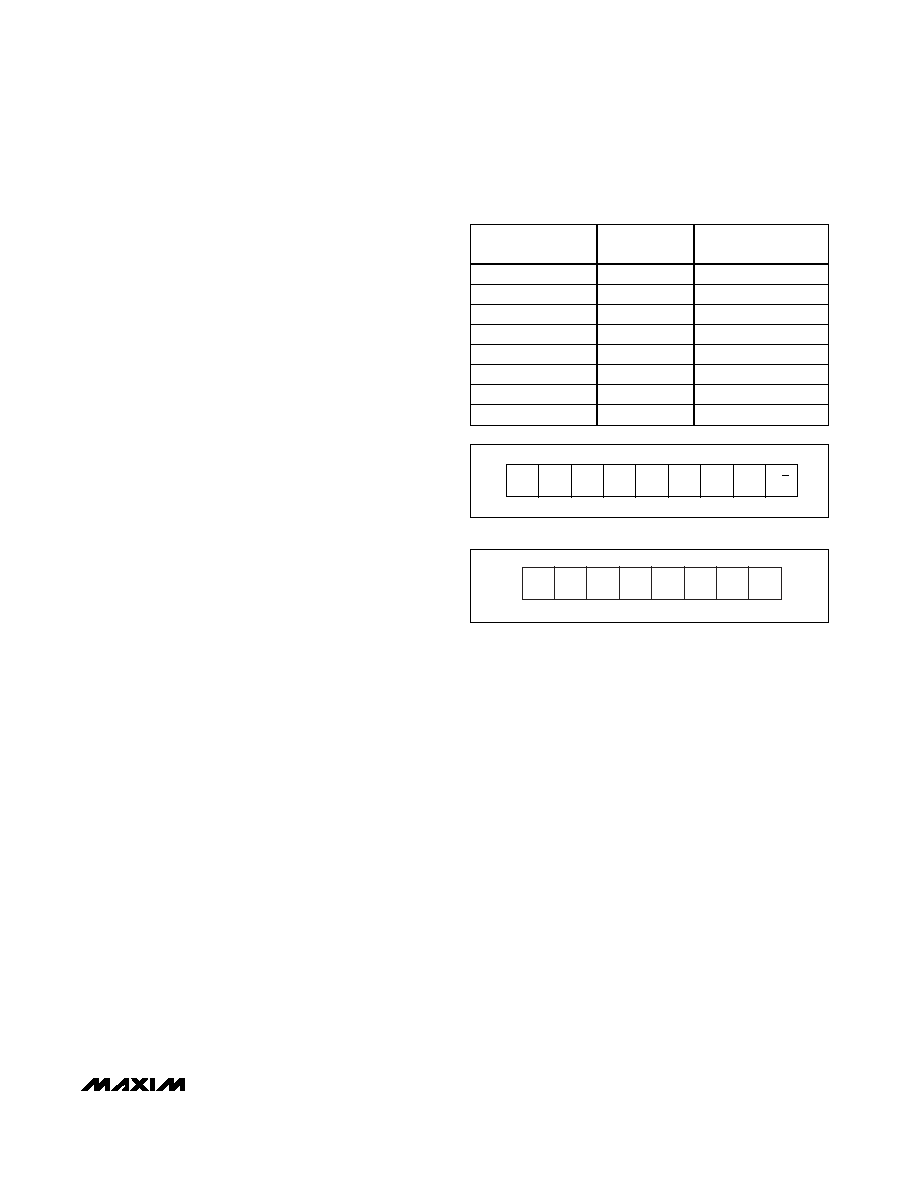- 您現(xiàn)在的位置:買賣IC網(wǎng) > PDF目錄8538 > MAX5811MEUT+T (Maxim Integrated Products)IC DAC SERIAL 10BIT 1CH SOT23-6 PDF資料下載
參數(shù)資料
| 型號: | MAX5811MEUT+T |
| 廠商: | Maxim Integrated Products |
| 文件頁數(shù): | 13/13頁 |
| 文件大?。?/td> | 0K |
| 描述: | IC DAC SERIAL 10BIT 1CH SOT23-6 |
| 產(chǎn)品培訓(xùn)模塊: | Lead (SnPb) Finish for COTS Obsolescence Mitigation Program |
| 標(biāo)準(zhǔn)包裝: | 2,500 |
| 設(shè)置時間: | 4µs |
| 位數(shù): | 10 |
| 數(shù)據(jù)接口: | 串行 |
| 轉(zhuǎn)換器數(shù)目: | 1 |
| 電壓電源: | 單電源 |
| 功率耗散(最大): | 727mW |
| 工作溫度: | -40°C ~ 85°C |
| 安裝類型: | 表面貼裝 |
| 封裝/外殼: | SOT-23-6 |
| 供應(yīng)商設(shè)備封裝: | SOT-6 |
| 包裝: | 帶卷 (TR) |
| 輸出數(shù)目和類型: | 1 電壓,單極 |
| 采樣率(每秒): | * |

MAX5811
10-Bit Low Power 2-Wire Interface Serial,
Voltage-Output DAC
_______________________________________________________________________________________
9
low transition on SDA with SCL high. A STOP condition
is a low-to-high transition on SDA while SCL is high
(Figure 2). A START condition from the master signals
the beginning of a transmission to the MAX5811. The
master terminates transmission by issuing a not
acknowledge followed by a STOP condition (see
Acknowledge Bit). The STOP condition frees the bus. If
a repeated START condition (Sr) is generated instead of
a STOP condition, the bus remains active. When a
STOP condition or incorrect address is detected, the
MAX5811 internally disconnects SCL from the serial
interface until the next START condition, minimizing digi-
tal noise and feedthrough.
Early STOP Conditions
The MAX5811 recognizes a STOP condition at any point
during transmission except if a STOP condition occurs in
the same high pulse as a START condition (Figure 3).
This condition is not a legal I2C format; at least one
clock pulse must separate any START and STOP condi-
tions.
Repeated START Conditions
A REPEATED START (Sr) condition may indicate a
change of data direction on the bus. Such a change
occurs when a command word is required to initiate a
read operation. Sr may also be used when the bus
master is writing to several I2C devices and does not
want to relinquish control of the bus. The MAX5811 ser-
ial interface supports continuous write operations with
or without an Sr condition separating them. Continuous
read operations require Sr conditions because of the
change in direction of data flow.
Acknowledge Bit (ACK)
The acknowledge bit (ACK) is the ninth bit attached to
any 8-bit data word. ACK is always generated by the
receiving device. The MAX5811 generates an ACK
when receiving an address or data by pulling SDA low
during the ninth clock period. When transmitting data,
the MAX5811 waits for the receiving device to generate
an ACK. Monitoring ACK allows for detection of unsuc-
cessful data transfers. An unsuccessful data transfer
occurs if a receiving device is busy or if a system fault
has occurred. In the event of an unsuccessful data
transfer, the bus master should reattempt communica-
tion at a later time.
Slave Address
A bus master initiates communication with a slave
device by issuing a START condition followed by the 7-
bit slave address (Figure 4). When idle, the MAX5811
waits for a START condition followed by its slave
address. The serial interface compares each address
value bit by bit, allowing the interface to power down
immediately if an incorrect address is detected. The
LSB of the address word is the Read/Write (R/W) bit.
R/W indicates whether the master is writing to or read-
ing from the MAX5811 (R/W = 0 selects the write condi-
tion, R/W = 1 selects the read condition). After
receiving the proper address, the MAX5811 issues an
ACK by pulling SDA low for one clock cycle.
The MAX5811 has eight different factory/user-pro-
grammed addresses (Table 2). Address bits A6
through A1 are preset, while A0 is controlled by ADD.
Connecting ADD to GND sets A0 = 0. Connecting ADD
to VDD sets A0 = 1. This feature allows up to eight
MAX5811s to share the same bus.
Write Data Format
In write mode (R/W = 0), data that follows the address
byte controls the MAX5811 (Figure 5). Bits C3–C0 con-
figure the MAX5811 (Table 3). Bits D9–D0 are DAC
data. Bits S1 and S0 are sub-bits and are always zero.
Input and DAC registers update on the falling edge of
SCL during the acknowledge bit. Should the write cycle
be prematurely aborted, data is not updated and the
SA6
A5A4A3A2A1A0
R/W
Figure 4. Slave Address Byte Definition
Table 2. MAX5811 I2C Slave Addresses
PART
VADD
DEVICE ADDRESS
(A6...A0)
MAX5811L
GND
0010 000
MAX5811L
VDD
0010 001
MAX5811M
GND
0010 010
MAX5811M
VDD
0010 011
MAX5811N
GND
0110 100
MAX5811N
VDD
0110 101
MAX5811P
GND
1010 100
MAX5811P
VDD
1010 101
C3
C2
C1
C0
D9
D8
D7
D6
Figure 5. Command Byte Definition
相關(guān)PDF資料 |
PDF描述 |
|---|---|
| VI-B31-MU-F1 | CONVERTER MOD DC/DC 12V 200W |
| LT1189CS8 | IC AMP VIDEO DIFFRNC ADJ 8-SOIC |
| MAX5811LEUT+T | IC DAC SERIAL 10BIT 1CH SOT23-6 |
| VE-B3R-MU-F4 | CONVERTER MOD DC/DC 7.5V 200W |
| VI-B4K-MX-S | CONVERTER MOD DC/DC 40V 75W |
相關(guān)代理商/技術(shù)參數(shù) |
參數(shù)描述 |
|---|---|
| MAX5811NEUT | 制造商:Maxim Integrated Products 功能描述:10-BIT LOW-POWER 2-WIRE SERIAL V - Cut Tape Product |
| MAX5811NEUT+T | 功能描述:數(shù)模轉(zhuǎn)換器- DAC 10-Bit Precision DAC RoHS:否 制造商:Texas Instruments 轉(zhuǎn)換器數(shù)量:1 DAC 輸出端數(shù)量:1 轉(zhuǎn)換速率:2 MSPs 分辨率:16 bit 接口類型:QSPI, SPI, Serial (3-Wire, Microwire) 穩(wěn)定時間:1 us 最大工作溫度:+ 85 C 安裝風(fēng)格:SMD/SMT 封裝 / 箱體:SOIC-14 封裝:Tube |
| MAX5811NEUT-T | 功能描述:數(shù)模轉(zhuǎn)換器- DAC RoHS:否 制造商:Texas Instruments 轉(zhuǎn)換器數(shù)量:1 DAC 輸出端數(shù)量:1 轉(zhuǎn)換速率:2 MSPs 分辨率:16 bit 接口類型:QSPI, SPI, Serial (3-Wire, Microwire) 穩(wěn)定時間:1 us 最大工作溫度:+ 85 C 安裝風(fēng)格:SMD/SMT 封裝 / 箱體:SOIC-14 封裝:Tube |
| MAX5811PEUT | 制造商:Maxim Integrated Products 功能描述:10-BIT LOW-POWER 2-WIRE SERIAL V - Rail/Tube |
| MAX5811PEUT+T | 功能描述:數(shù)模轉(zhuǎn)換器- DAC 10-Bit Precision DAC RoHS:否 制造商:Texas Instruments 轉(zhuǎn)換器數(shù)量:1 DAC 輸出端數(shù)量:1 轉(zhuǎn)換速率:2 MSPs 分辨率:16 bit 接口類型:QSPI, SPI, Serial (3-Wire, Microwire) 穩(wěn)定時間:1 us 最大工作溫度:+ 85 C 安裝風(fēng)格:SMD/SMT 封裝 / 箱體:SOIC-14 封裝:Tube |
發(fā)布緊急采購,3分鐘左右您將得到回復(fù)。